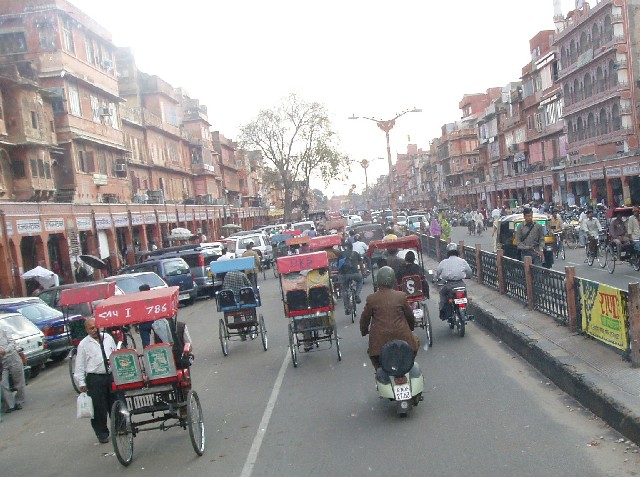25 Mar 2005
The Colourful Indian City Of Jaipur
It does not take long for a visitor to notice the distinguishing features of this Indian city of less than three million people. My group of forty visitors from Cameroon arrived Jaipur mid March during a ten-day visit to India. This is a city where almost all houses are painted with the same pink colour and the imposing relics of her imperial past in the form of palaces and fortresses are a common sight. Situated some 250 kilometres South West of Delhi, Jaipur is the capital of the mostly arid Indian state of Rajasthan (land of the Rajputana). Rajasthan has a history of wars among the early settlers that occupied it in the past and the groups that prevailed “emerged as the martial race of the brave, loyal and chivalrous Rajputs”. Each kingdom was ruled by a king called maharaja or raja. Even though the state has returned to modern democratic rule, the influence and impact of the descendants of maharajas is still very present. According to a publication The Glorious Cities “The nucleus of this Pink city is the sprawling City Palace (Maharaja property) covering almost one-seventh of Jaipur’s area”. A visit to the city palace confirmed this statement and explains why the maharaja family is one of the richest in India.
We also visited another impressive palace complex at Amer on the outskirts of Jaipur called Amber fort. Perched on top of a hill with other imperial complexes, this was used as the summer palace by the Maharaja. The opulence and luxury emanating from the palace that we gained access on the back of elephants bore testimony to the insatiable taste of the rulers of yesteryears. We were shown the living quarters of the emperor’s 500 concubines and that of his official wife! On our way back from Amber fort, we stopped at a carpet manufacturing plant where we were shown the sixteen steps employed in carpet manufacturing. The art of making carpets in Jaipur dates back to over four centuries.

Street in Jaipur
Back to the streets of Jaipur’s inner city you could see how almost everything has been converted to transport people and goods. You can see carts drawn by cows, buffalos, donkeys, camels and horses. You can also see cars, bicycles, three wheeled vehicles, motorbikes and all types of adaptable motorized devices all competing for available space on the road. It was an interesting site when I saw an elephant-rider adding colour to the already exciting melee of transporters. When visitors step on the sidewalks they are swarmed by the usual hordes of hawkers and beggars. These two groups of people are very aggressive, persuasive and parasitically persistent in drawing your attention to them. They can usually go an extra mile to actually obstruct you on the path you are walking. In Jaipur, like many Indian cities, cows (considered Sacred by Hindus) are allowed to roam the streets freely and return in the evening to sleep on the verandas of their owners. The Hindus and the Sikhs do not eat cattle meat.
One of our evenings in Jaipur was spent at Samode palace (another imperial monument) situated about 45 kms on the outskirts of Jaipur. Here we were adorned with garlands, showered with flowers and treated to an evening of Indian dancers and buffet.
It is only when we were invited to join the dancers on stage did we notice that Indian musical steps are not as easy as we imagined. The occasion came to a close with a spectacle of colourful fireworks.
Another site of attraction is the Birla (Hindu) temple in Jaipur. This beautiful temple constructed with white marble was quite appealing. I was curious to know why on some pillars on the outside wall bore inscriptions like “Jesus Christ”, “Maddona with Christ”,“Confucius” and a clearly marked swastika emblem. Our guide explained that Hinduism was a liberal religion that recognizes the beliefs of others, hence the inscriptions. On the swastika emblem that was made infamous by Nazi Germany, he told us that it was an old Hindu religious symbol. I was later to confirm his assertion as I saw it many times over on other Hindu temples and also witnessed that the central tables at a marriage ceremony in Agra were arranged in the form of a swastika.
I met a group of curious people from central India at the temple that inquired where we came from? “Cameroon” I replied. “Do you like India?” one asked. “Yes of cause” came my answer. “really”? another inquired. “Yes but I need to take a wife from India to Cameroon to cement my love for India.” I answered as all of them burst into laughter. It should be noted that marriage outside one’s socio-cultural milieu is discouraged and frowned upon in most of India.
Talking about Marriage, our guide Gopal had this to say “Over 90% of marriages in India are arranged and family reputation is an important factor in these arrangements.” “We say you marry once in your life and marriage comes before love. In India, people are expected to marry as virgins and divorce is rare.” He added; “My own wife was chosen by my mother and my mother lives with us. As a matter of respect, all the money I give to my wife goes through my mother.” I could clearly hear Cameroonian women in the bus murmuring with disagreement over this point.
Copyrightã2005 by Njei Moses Timah
Njei Moses Timah [e-mail]
|